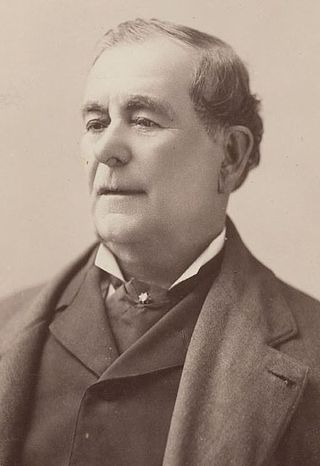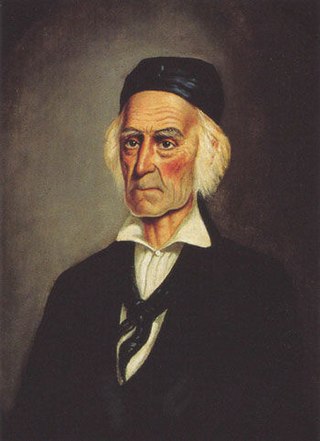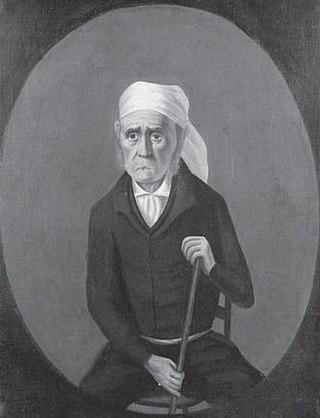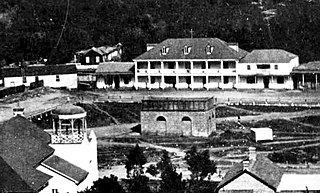
The Lugo family of California were prominent during the periods of Spanish and Mexican rule. They were among the early colonists who became known as Californios .

The Lugo family of California were prominent during the periods of Spanish and Mexican rule. They were among the early colonists who became known as Californios .
Francisco Salvador Lugo (1740–1805), born in Sinaloa, Mexico, came to Las Californias in 1774. He was a soldier in the province and was stationed in northern California until 1781. Next he was assigned as part of the founding of the Pueblo de Los Angeles. Francisco Lugo was one of the soldiers who escorted the Los Angeles Pobladores (farming families and colonists) in 1781 from northern Mexico into California. His name is listed on the plaque of those present at the founding of Los Angeles on September 4, 1781. [1] [2] Lugo married Juana María Martínez y Vianazul. Together they had nine children: Rosa María de Lugo (1761–1797), María Tomasa Ygnacia Lugo Martínez (1763–1816), Salvador Lugo (1766–1784), Gerónimo Teodoro Lugo (1773–?), José Ignacio de Lugo (1775–1800), María Antonia Isabel Lugo (1776–1855), Antonio María Lugo (1778–1860), Juan María Alejandro de Lugo (1780–1830), and María Ygnacia de Lugo (1783–1798).
Antonio Maria Lugo (1778–1860) was born at Mission San Antonio de Padua in present-day Jolon, California, the seventh son of Francisco Salvador Lugo. After 17 years of service at the Presidio of Santa Barbara, in 1810 Corporal Lugo received his discharge and settled with his family in the Pueblo de Los Angeles. Antonio Lugo was granted the Spanish concession Rancho San Antonio in 1810, which was confirmed in 1838 by Mexican governor Juan Alvarado. In 1816, he served as the alcalde (mayor) of Los Angeles. In 1841, Lugo was granted Rancho Santa Ana del Chino by governor Alvarado. On Rancho San Antonio he built Casa de Rancho San Antonio the oldest home in Los Angeles County, California. [3]
Antonio and his wife Maria de Los Dolores Dominguez Lugo had five sons: José del Carmen, José Maria, Felipe, José Antonio, and Vicente Lugo (namesake of the Lugo Adobe); and 3 daughters: Vicenta Perez, Maria Antonia Yorba, and María Merced Lugo. Maria married Stephen Clark Foster, the first American mayor of Los Angeles after the Mexican–American War. [4] [5] [6]
José del Carmen Lugo (1813 –c. 1870) was a major 19th-century Californio landowner in Southern California. [7]
He was born in 1813 at the Pueblo de Los Angeles, in Spanish colonial Alta California, then a province of the Viceroyalty of New Spain. José del Carmen Lugo was the eldest son of Antonio Maria Lugo. [7]
José del Carmen Lugo, in a joint venture with his brothers José María and Vicente Lugo and cousin Diego Sepúlveda, began colonizing the San Bernardino Valley and adjacent Yucaipa Valley. The land covered more than 250,000 acres (1,012 km2) in the present-day Inland Empire. Their colony charter was approved by the Mexican government in 1839. [7] The valley was plagued by robberies and frequent raids by California Indians resisting loss of their homeland. Many would-be colonizers would stay only for short periods of time. The Lugo families became strong allies with the Mountain Band of Cahuilla Indians led by Chief Juan Antonio.
In 1842, the Lugo family bought the San Bernardino Asistencia, a former "sub-mission" of Mission San Gabriel. The adobe buildings were in disrepair. Lugo made repairs and soon he and his wife and two daughters moved into the asistencia. [7]
By 1842, the Mexican governorship of California was about to change. To protect their land, the Lugo family applied for and received the Rancho San Bernardino Mexican land grant of 35,509 acres (144 km2). [7]
During the Mexican–American War, Lugo led a Californio militia. In December 1846, he was ordered to punish a band of Luiseño Indians in retaliation for the Pauma Massacre. His militia forces, together with allied Cahuilla, killed 33–40 Luiseño in the Temecula Massacre to avenge the deaths of 11 Californio lancers. The latter were killed for stealing horses from the Luiseño.
He was the leader of Californio forces during the Battle of Chino and the Temecula Massacre. By January 1847, he was placed in charge of the Chino prisoners by General José María Flores. Lugo escorted the prisoners to the Rancho Santa Ana del Chino and released them.
In March 1847, he met with the American John Charles Fremont in Los Angeles. Fremont requested that Lugo round up as many of Flores's abandoned horses as possible. Lugo rounded up about 60 horses between Los Angeles and San Bernardino.
The United States won the Mexican–American War and annexed California in 1848. In May 1849, U.S. military Governor Richard Barnes Mason appointed Lugo as the first Mexican-Californio mayor of Los Angeles after U.S. control began. [7] He served after American Stephen Clark Foster (1848 – mid-1849), and before Alpheus P. Hodges (mid-1850 – 1851).
In August 1849 he was elected Justice of the Peace of Los Angeles and served until January 1850.
In 1852, Lugo sold Rancho San Bernardino to Amasa M. Lyman and Charles C. Rich, apostles of the Church of Jesus Christ of Latter-day Saints. Lugo's fortunes changed for the worse in later years. In 1854, he signed a note at five percent interest per month, compounded monthly, and mortgaged all of his property, including his home in Los Angeles. He lost his house and his land in Los Angeles to cover the note. [7]
José del Carmen Lugo died in poverty in 1870.
Felipe Lugo was baptized on August 6, 1807, at Mission San Gabriel. [8] He married Maria "Pancha" Perez and they were parents to as many as 16 children. [9] He died on May 9, 1885, at Rancho San Antonio and is buried at Old Calvary Cemetery in Los Angeles. [10]
Rancho Potrero de Felipe Lugo is named for him.

Don Mariano Guadalupe Vallejo was a Californio general, statesman, and public figure. He was born a subject of Spain, performed his military duties as an officer of the Republic of Mexico, and shaped the transition of Alta California from a territory of Mexico to the U.S. state of California. He served in the first session of the California State Senate. The city of Vallejo, California is named after him, and the nearby city of Benicia is named after his wife.

Rancho Cucamonga was a 13,045-acre Mexican land grant in present-day San Bernardino County, California, given in 1839 to the dedicated soldier, smuggler and politician Tiburcio Tapia by Mexican governor Juan Bautista Alvarado. The grant formed parts of present-day California cities Rancho Cucamonga and Upland. It extended easterly from San Antonio Creek to what is now Hermosa Avenue, and from today's Eighth Street to the mountains.

Californio is a term used to designate a Hispanic Californian, especially those descended from Spanish and Mexican settlers of the 17th through 19th centuries. California's Spanish-speaking community has resided there since 1683 and is made up of varying Spanish and Mexican origins, including criollos, Mestizos, Indigenous Californian peoples, and small numbers of Mulatos. Alongside the Tejanos of Texas and Neomexicanos of New Mexico and Colorado, Californios are part of the larger Spanish-American/Mexican-American/Hispano community of the United States, which has inhabited the American Southwest and the West Coast since the 16th century. Some may also identify as Chicanos, a term that came about in the 1960s.

Rancho San Antonio is a 29,513-acre (119.43 km2) Spanish land grant in present-day Los Angeles County, California that was granted to Antonio Maria Lugo. The rancho included the present-day cities of Bell, Bell Gardens, Maywood, Vernon, Huntington Park, Walnut Park, Cudahy, South Gate, Lynwood and Commerce.
The Pauma massacre occurred in December 1846, at Pauma Valley north of Escondido, California. Luiseño Indians killed eleven Mexicans, Californio lancers who had stolen horses from them. The action was related to a series of regional conflicts during the Mexican–American War and followed the Battle of San Pasqual in California. Fundamentally, it was also related to the appropriation of Mission Luiseno land from the Luiseño after the successful mission with a population of 3,000 was secularized in 1833. Gov. José Figueroa had granted the Luiseño three pueblos including Las Flores and San Pascual. Pío Pico was to hold the mission land in trust for the government as administrator pending a decision on what to do with it. Eventually, Pico took Las Flores as his personal ranch. Pico was the man who led the Mexicans at the battle of San Pascual. The Kumeyaay Indians lived at San Pascual, though the Kumeyaay were from the next mission, San Diego, they also viewed Pio Pico with distrust, and their sympathies for the Americans may have been decisive, given their knowledge of the terrain in which they lived. The Mexicans lost and afterwards took 11 horses from a nearby Luiseño community, which then retaliated by killing 11 Mexican Californio soldiers at the Massacre of Pauma.
The Temecula massacre took place in December 1846 east of present-day Temecula, California, United States. It was part of a series of related events in the Mexican–American War. A combined force of Californio militia and Cahuilla Indians attacked and killed an estimated 33 to 40 Luiseño Indians. The Mexican authorities in California took the military action in retaliation for the Indians' killing 11 Californio lancers, in what was called the Pauma Massacre.
General José María Flores was a Captain in the Mexican Army and was a member of la otra banda. He was appointed Governor and Comandante Generalpro tem of Alta California from November 1846 to January 1847, and defended California against the Americans during the Mexican–American War.

Rancho La Ballona was a 13,920-acre (56.3 km2) Mexican land grant in the present-day Westside region of Los Angeles County, Southern California.

Los pobladores del pueblo de los Ángeles refers to the 44 original settlers and 4 soldiers from New Spain (Mexico) who founded the Pueblo de Nuestra Señora la Reina de los Ángeles in 1781, which is now the present-day city of Los Angeles, California.

San Timoteo Canyon is a river valley canyon southeast of Redlands, in the far northwestern foothills of the San Jacinto Mountains in the Inland Empire region of Southern California.

Rancho San Bernardino was a 35,509-acre (143.70 km2) Mexican land grant in present-day San Bernardino County, California given in 1842 by Governor Juan B. Alvarado to José del Carmen Lugo, José María Lugo, Vicente Lugo, and Diego Sepulveda. The grant included a large part of the San Bernardino valley, and encompassed present-day San Bernardino, Fontana, Rialto, Redlands and Colton.

Rancho Santa Ana del Chino was a 22,193-acre (89.81 km2) Mexican land grant in the Chino Hills and southwestern Pomona Valley, in present-day San Bernardino County, California.
The Battle of Chino, a skirmish of the Mexican–American War occurred on September 26–27, 1846, during which 24 Americans led by Benjamin D. Wilson, who were hiding in the adobe house of Rancho Santa Ana del Chino, were captured by a group of about 50 Californios.

The Ávila family was a prominent Californio family of Spanish origins from Southern California, founded by Cornelio Ávila in the 1780s. Numerous members of the family held important rancho grants and political positions, including two Alcaldes of Los Angeles.
Rancho Little Temecula was a 2,233-acre (9.04 km2) Mexican land grant in present-day Riverside County, California given in 1845 by Governor Pío Pico to Pablo Apis. The grant was one of the few held by indigenous people. The grant is south of present-day Temecula and is bordered on the north by Temecula Creek. At the time of the US patent, Rancho Little Temecula was a part of San Diego County. Riverside County was created by the California Legislature in 1893 by taking land from both San Bernardino and San Diego Counties.
Juan Antonio (1783–1863), Cahuilla name: Cooswootna, Yampoochee,, was a major chief of the Mountain Band of the Cahuilla from the 1840s to 1863.

Doña María Ygnacia López de Carrillo was a Californio ranchera. She was the founder of Santa Rosa. She married into the prominent Carrillo family of California and was the ancestor of numerous prominent Californians.
Isaac Williams (1799–1856) was an American fur trapper, merchant, later a rancher and owner of Rancho Santa Ana del Chino in what is now the cities of Chino and Chino Hills in San Bernardino County, California.

The Casa de Rancho San Antonio, also known as the Gage Mansion, is the oldest remaining house in Los Angeles County. Construction began in 1795 by Antonio María Lugo, a prominent Californio ranchero. Today, the California Historic Landmark is located within the city of Bell Gardens, California.

The Lugo Adobe also called the Vicente Lugo Adobe or Casa de Don Vicente Lugo was a house in the city of Los Angeles, located on the east side of the Los Angeles Plaza at 512–524 N. Los Angeles Street.